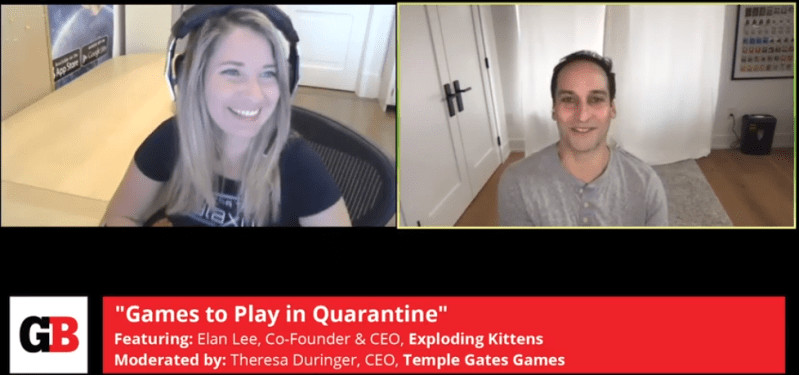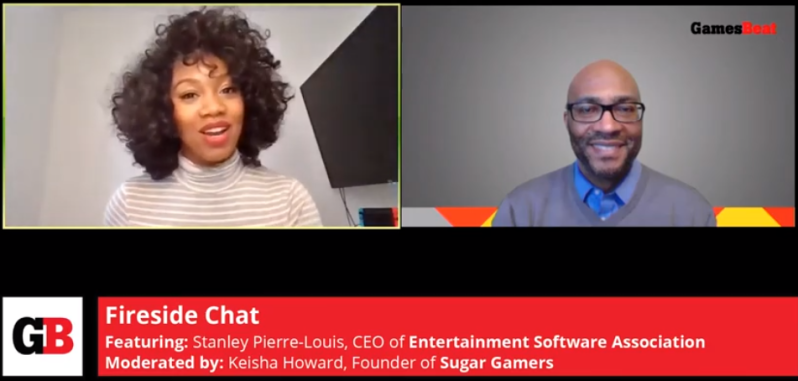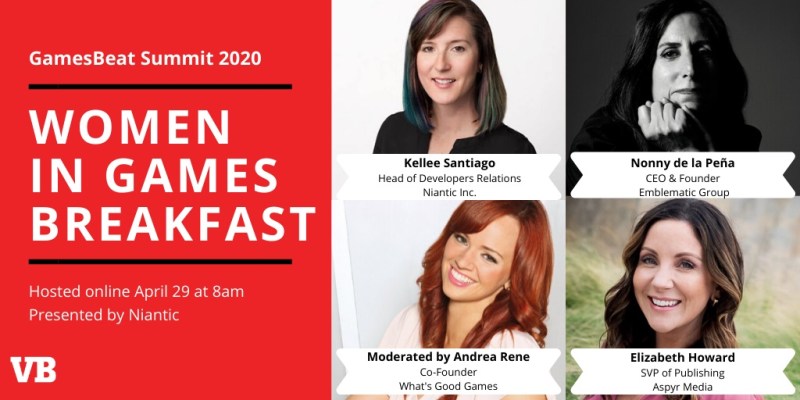Thank you to those of you who tuned into our online-only GameBeat Summit 2020 event this week. I had a great time, even though I didn’t come within miles of anyone who attended the digital event.
This event was a wake-up for me and many of our guests. Many attendees told us that we proved it was possible to do a good digital event. But it wasn’t easy to pull off, as our plans kept changing in real time. I’m very proud our team at VentureBeat stepped up to this challenge. And it turns out this was kind of an interesting lesson on how to take something meant only for the physical world into the digital future.
At our event on Tuesday and Wednesday, we had about 600 people in our summit’s Slack channels and about 1,800 registered to view the Zoom video proceedings across two different stages. We also streamed the event to the larger public on YouTube, Twitter, Mixer, and Twitch. We had 121 speakers in 59 sessions. It was a very complicated event to organize, particularly within the eight-week window that we had to pivot the event from a physical event in Los Angeles to a video conference event.
And we managed to grow our event year over year, as in 2019 we had 510 in-person attendees.
June 5th: The AI Audit in NYC
Join us next week in NYC to engage with top executive leaders, delving into strategies for auditing AI models to ensure fairness, optimal performance, and ethical compliance across diverse organizations. Secure your attendance for this exclusive invite-only event.
Living in denial

Above: GamesBeat Summit Digital speakers.
We were not preprogrammed for success. All of this came together very quickly.
At the DICE Summit in Las Vegas in mid-February, I was booking speakers and talking with folks about our plans for the Women in Gaming breakfast. But after I returned, the coronavirus was gathering steam. Tech companies bailed out on Mobile World Congress, the big trade show in Barcelona. On February 21, Sony and Facebook pulled out of the Game Developers Conference in San Francisco.
On February 26, San Francisco declared a state of emergency. Then, when the last major sponsor (Amazon) pulled out on February 28, GDC was canceled (or rather, postponed).
To me, during those days, it felt like we were dodging a bullet. Los Angeles, where we planned to do our event, was still open for business. I didn’t think the lockdown and fear of being social would last until the end of April. And companies that couldn’t show anything at GDC were now asking if they could come to the GamesBeat Summit on April 28 and April 29. That seems so naive today. But back at the end of February, some of us still thought we could do a physical event, as it wasn’t going to be a massive collection of people.
On February 29, one of my college friends who works in epidemiology warned me that by the time April came around, the pandemic would be markedly worse, with lots of people dying and most people in no mood to gather for physical events. We wondered if people would attend a mostly digital event, and if a smaller group would come to a physical event.
By Monday, March 2, I spoke with my boss Matt Marshall, the CEO of VentureBeat, and we reasoned that it would make no sense to move the event later in the year, when we might have even more people infected and more problems with a physical event. We decided to keep the event in April but started planning for an all-digital contingency. We thought we would bring people together to record sessions at a studio, with a small or no audience. We tried to hang on to that physical presence, as one CEO said he would skip it if it were just a digital event.
On March 3, we announced we would still do our event, perhaps as a small regional event, but we would reschedule it if necessary. On March 5, I attended the investor meeting for Advanced Micro Devices; it was my last physical event I went to as a journalist. Things were getting bad in Seattle, with lockdowns and deaths occurring in a major American city.
I was really starting to resent this “force majeure,” which was coming on so fast to ruin our plans as well as wreck the economy and endanger so many lives. I was getting dragged kicking and screaming into changing our event. And yet, I also realized this problem wasn’t just about me or my event. This was about being responsible and safe.
We had to do the right thing.
Pulling it all together
We also realized that we had one of the biggest fights of our careers on our hands. The easy thing would be to cancel it outright.
I signaled to our advisers that we would do a “digital-first” event, where the audience would be mostly online but possibly with some small gathering at the recording studios in San Francisco and Los Angeles. But Bill Grosso, one of our advisers, cautioned us to just drop the physical part altogether.
And soon enough, on March 11, the NBA suspended its whole season after a player tested positive. E3, the big game event in June, was canceled the same day. Speakers were starting to tell us they would not be able to travel to a physical event. Niantic, one of our sponsors, said it would still support us if we had a digital event. That gave us some energy to move forward. During that week, we went all-digital. But we had just about six weeks to make that transition.
By March 14, I had made my last trip to our local gym. We were locked down in our home, and I was unable to meet with the rest of our staff. On March 16, we told the public we would shift to a digital format. On March 19, we spoke with Rami Ismail, the cofounder of Vlambeer and co-creator of the Gamedev.World event, which was an all-digital conference for game developers. He had successfully staged that in 2019 and had great advice for us to take advantage of the digital format. He told us, for instance, that we should prerecord many talks.
By the end of March, we hired a production company that was familiar with digital events, Evergreen Creative. We had worked with them before, and Rob Lee knew a lot about what we could do in a digital format. We toyed with different platforms but settled upon Zoom and Slack. We chose Zoom because it would enable us to keep our two simultaneous video stages, and we chose Slack as a means to communicate. We considered a mobile app for scheduling 1-on-1 meetings but felt that was going to be too many platforms.
We almost went with another platform. In a critical move, we decided to ditch it because it would have forced us to have only one main stage, and we had already booked speakers for simultaneous dual stages. We didn’t want to cut the speaker roster, which was excellent. So we settled on Zoom for good, even though it had its flaws and scary stories of “Zoom-bombing” proliferating.
Meanwhile, many speakers continued to commit to speaking at our event. We realized that we needed to fill out the time for things like lunch, so we signed up more speakers so we didn’t have any gaps in our day-long schedule, as we didn’t want to lose our online audience by going dark with dead air.

Above: Kesiha Howard (left) of Sugar Games hosts a fireside chat with Entertainment Software Association CEO Stanley Pierre-Louis on the industry and gaming for good in the era of the coronavirus.
We recorded a practice Zoom session with Fable Studio CEO Edward Saatchi on March 27. That was the first time we tried it, and we realized that internet connectivity was an issue for things like iPads and iPhones. Then we went into overdrive booking recordings with speakers on wired connections with good webcams, solid microphones, and desktop PCs where possible. During the next three weeks, we recorded more than 35 of the 59 sessions with speakers, using Evergreen and our PC gaming editor, Jeff Grubb. Those recording sessions and prep calls were quite memorable, as for some of us, they were the only real human contact we were having outside of our families.
We even filmed a tutorial on how to use Slack and Zoom, and our GamesBeat editorial team and freelancers Aron Garst and Amanda Farough were able to write stories about a lot of the talks and schedule them.
That took the edge off going live, as the majority of talks were now available as recordings that we could drop into the show. We arranged for many speakers to come on live only for the Q&A part of their talks. That part was critical for boosting engagement, while the recordings were crucial in reducing the number of things that could go wrong during a live event. About a week early, we opened up the Slack channels for the conference and people started pouring into it to chat.
In our rehearsals on April 24 and April 27, we uncovered some challenges in how we were orchestrating the speaker Q&A sessions, but we decided to move forward and leave it flexible. We pulled together volunteers from partners such as USC and veterans of the game industry. We needed them to tell us if any Zoom-bombing was happening.
We also put final details on touches that could make our event better, like our Visionary Awards presentation and a film excerpt from Insert Coin, a documentary about Midway Games, that we would show in a reception featuring the cool technologies of Oculus Venues and Hearo.Live. Oculus Venues let people watch the proceedings in virtual reality, while Hearo.Live let us watch with audio chat.
How it turned out

Above: The IDGA’s Renee Gittins (right) and Xsolla’s Justin Berenbaum talk game subscriptions in the era of the coronavirus during GamesBeat Summit 2020.
For our Visionary Awards, we were able to recognize the groundbreaking work on mental wellness by industry leaders Eve Crevoshay and John Smedley. Those awards were quite timely, as we all need more mental wellness in the stressful time of the coronavirus. The preparations for the awards came in hot, but no one on our organizing committee complained about the short time frame.
As April 28 and April 29 arrived, we were pleased to see the crowd had become more international than ever, and that we still had some of the highest-level people in the industry coming to listen to talks, chat with each other in video conferences, and write supportive messages and banter in the Slack channels. To me, this was a huge relief. And I had some very nice moments talking with industry friends on Zoom.
More than 100 women (sorry, some couldn’t get inside the virtual room) attended our first-ever Women in Gaming virtual breakfast, led by our Hero Stage emcee Andrea Rene of What’s Good Gaming. I was proud that we had diversity in our ranks. Twenty-five speakers were women, or about 20%, roughly the same ratio of women in the industry; about 38% of the speakers were women or people of color.
In my final speech, I thanked 14 sponsors, eight media partners, and 34 individuals who were critical to the event. Most of our speakers we recruited before the event stayed with us, including some that I had to beg to stay on board with us. We did this with a small team, but one that was nimble and unwilling to give up.
What we learned

Above: Women in games breakfast at GamesBeat Summit Digital.
Our advisory board was very helpful in pushing us more and more digital. But it was good to figure out what we were capable of. We knew we could not have rescheduled 50 speakers to accommodate a new technology platform, so we stayed with an older one that people knew. Zoom and Slack aren’t perfect, but when used together, they’re pretty good. And that was good enough to get this event done.
We learned that we had to reduce the number of moving parts, which represented things in the show that could go wrong. We had to have backups for everything. We could play a prerecording if a speaker didn’t show up in person. We had backup emcees in case the main emcees lost their internet connections. We had to make sure nothing fell through the cracks that would be visibly bad for the audience.
At the same time, we needed to leave some parts unscheduled. While I recorded that early session with Saatchi, we decided to go live with our talk on “We are what we pretend to be,” about designing virtual beings, or artificial people, for video games. It turned out to be a great seemingly spontaneous but well-rehearsed conversation — one that I’ll write about in the future.
Asked in advance, many speakers didn’t want to do live Q&A sessions. They were unfamiliar with this kind of format. But we left those parts vague in the schedule. When the speakers arrived onstage and started answering questions, they became more comfortable. So they agreed to move offstage and entertain questions, the same way that speakers do when they leave a physical stage and talk to people in a hallway. Some people stayed in these offstage Zoom rooms for a long time. That really boosted engagement, and it made the experience for the attendees much more special. Observers heard about this and upgraded to ticket holders from just watching free livestreams.
We had occasional problems, but overall, it was a success. In fact, it was one of the best conferences we’ve ever done. Now we’re planning on doing more digital conferences, such as our upcoming Transform event in July. In some ways, it feels like being pioneers. I don’t want to do digital events instead of physical events forever, but cold reality tells me we should get serious about being digital. Our team is even talking about doing this kind of event for other companies. That would be an entirely new business for us.
I’m very thankful that we survived this pivot from physical to digital. But I’m also very proud that our team enabled us to kick some ass in this transition.

